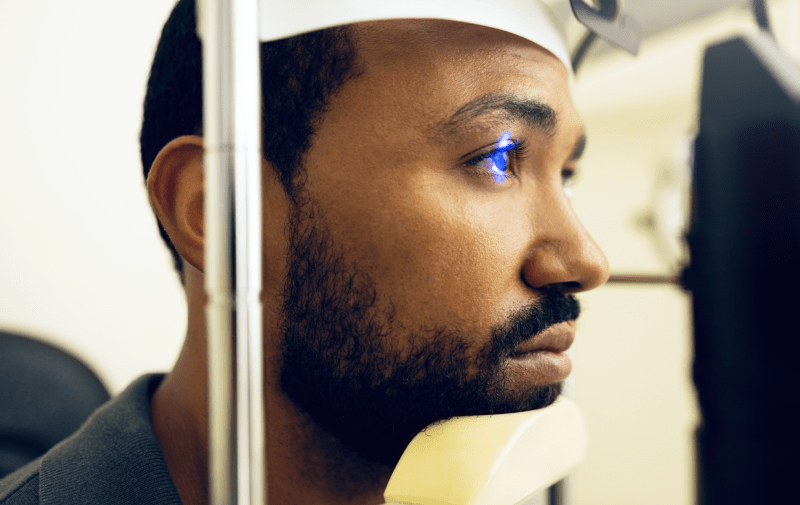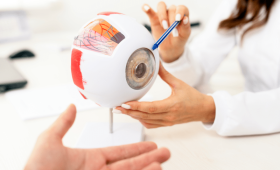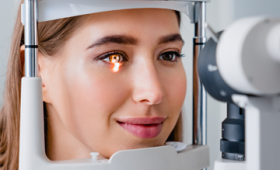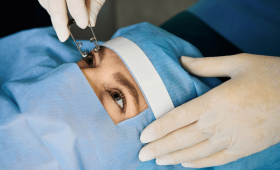What Is Hypermetropia And How Does It Arise?
Hypermetropia (farsightedness—clear distance vision, blurry near vision) is a common refractive error that occurs when light rays entering the eye focus behind the retina. This condition is usually caused by the eyeball being shorter than normal (axial hypermetropia) or the refractive power of the cornea and lens being insufficient.
It particularly strains the ability to see near objects and leads to symptoms such as eye fatigue and headaches after long periods of reading or computer use. This condition, especially when combined with presbyopia which increases with age, can create serious problems, and it is important to consult an expert ophthalmologist in Turkey for the correct treatment.
What Are The Most Common Symptoms Of Hypermetropia?
The most common symptoms of hypermetropia include blurry vision of near objects. Patients often struggle with close-up tasks such as reading, using a phone, or doing handicrafts. After long periods requiring focus, they may experience intense eye strain, watery eyes, and throbbing headaches in the forehead region. In cases of severe hypermetropia that emerge early in life, there is also a risk of strabismus (squint). If such symptoms are reducing your quality of life, you should consider receiving treatment in Turkey for a permanent solution.
Is Hypermetropia Treatment In Children Different From Adults?
Yes, hypermetropia treatment in children is fundamentally different from adults because children’s eyes can compensate for low prescriptions thanks to their accommodation (focusing) ability. Therefore, low-grade hypermetropia usually does not require glasses. However, if there are high degrees of hypermetropia or a risk of strabismus, the use of glasses is mandatory. Surgical treatments (like LASIK) are not applied until eye prescriptions stabilize (usually age 18 and older). Treatment in children focuses on ensuring visual development and preventing strabismus.
Which Laser Treatments Are Suitable For Hypermetropia?
The most commonly applied laser treatments for hypermetropia are LASIK, Femto-LASIK, and PRK. In hypermetropia treatment, the laser increases the refractive power of the cornea by thinning its periphery instead of its center, thereby focusing light correctly onto the retina. Femto-LASIK is considered safer for hypermetropia because the precision during the flap creation stage better preserves the stability of the cornea. The patient’s corneal thickness and prescription determine which laser method will yield the best result.
Why Is Femto LASIK Safer In Hypermetropia Treatment?
Femto-LASIK (bladeless laser) is considered safer than traditional LASIK in hypermetropia treatment because the corneal flap is created with a laser instead of a mechanical blade. This allows the flap to be cut thinner, more regularly, and with higher precision. In hypermetropia treatment, since the tissue surrounding the center of the cornea is preserved and the laser is applied to the periphery, preserving the biomechanics of the cornea is vitally important. This high precision provided by Femto-LASIK reduces the risk of complications and enhances long-term success.
Up To Which Degree Can Laser Treatment Correct Hypermetropia?
Laser treatment (LASIK and Femto-LASIK) can generally successfully correct hypermetropia up to +4.00 to +5.00 diopters. However, the maximum degree that can be corrected depends on factors such as the patient’s corneal thickness, corneal map (topography), and stability of the eye structure. In patients with high prescriptions (above +5.00) or insufficient corneal thickness, safer treatments such as Intraocular Lens (ICL) or Trifocal/EDOF Lens are recommended instead of laser. The specialist physician determines the safest upper limit based on pre-examination results.
Is ICL Lens An Alternative In Hypermetropia Treatment?
Yes, ICL (Implantable Collamer Lens) treatment is an excellent alternative for patients with insufficient corneal thickness or high hypermetropia prescriptions. ICL is based on the principle of placing a permanent contact lens inside the eye while preserving the eye’s natural lens. Since corneal tissue is not removed, corneal stability is preserved, which increases treatment safety. ICL provides high-resolution and permanent visual quality even in cases where LASIK cannot be applied and is successfully performed in expert centers in Turkey.
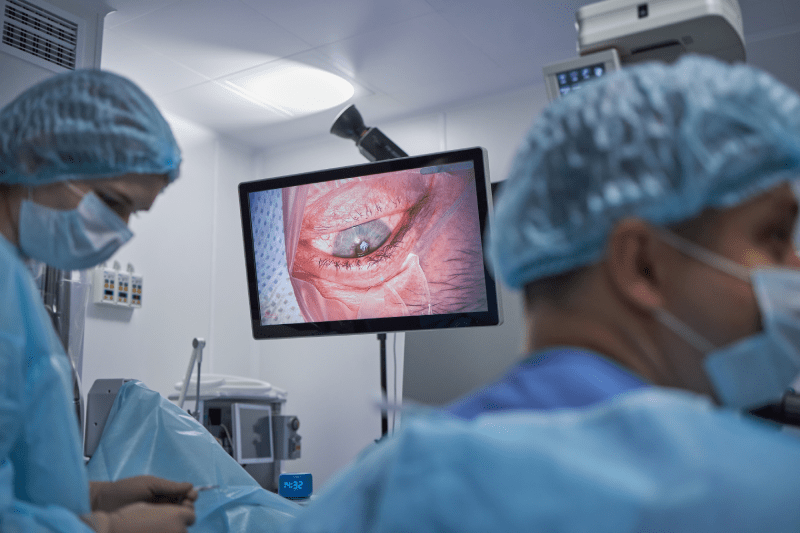
Can Laser Treatment Correct Astigmatism Simultaneously?
Yes, laser treatments applied for hypermetropia (LASIK, Femto-LASIK, PRK) can correct astigmatism successfully at the same time. Astigmatism is caused by the irregular shape of the cornea. Laser devices reshape the cornea to correct hypermetropia while also eliminating the irregularity caused by astigmatism. This combined correction allows the patient to achieve clear and focused visual quality with a single procedure. The ophthalmologist uploads the degree of astigmatism and the correction plan to the laser device based on pre-examination results.
Is Near Vision Difficulty (Presbyopia) Experienced After Laser Treatment?
Laser treatment only corrects the distance vision defect (myopia/hypermetropia). Near vision difficulty (presbyopia) is a biological process that generally occurs after the age of 40 due to the loss of flexibility of the eye’s natural lens. Laser treatment does not prevent this condition. Patients aged 40 and older may require reading glasses after the laser due to presbyopia. To resolve this, the doctor may recommend the Monovision technique or Trifocal/EDOF Lens treatments in older patients.
Why Should Turkey Be Preferred For Hypermetropia Treatment?
The main reasons for choosing Turkey for hypermetropia treatment are the cost advantage of 50% to 70% compared to European prices, advanced technology hospitals with JCI accreditation, and expert eye surgeons with high case experience. Clinics in Turkey use the most up-to-date laser devices like Femto-LASIK, and thanks to low operational costs, they offer this superior technology at more affordable prices. Professional institutions like Cure Holiday make the treatment process stress-free with packages that also include accommodation and transfers, strongly encouraging patients to receive treatment in Turkey.
What Is The Average Cost Of Hypermetropia Laser Treatment?
The average cost of hypermetropia laser treatment (Femto-LASIK) in Turkey is one-third the price of equivalent treatment in Western countries. Prices vary according to the laser technology used (personalized treatments like i-LASIK are more expensive), the scope of the package (transfer, accommodation), and the surgeon’s expertise level. This cost ensures that patients receive high-quality surgery while also covering their travel expenses, significantly relieving the budget. For transparent pricing, you can contact Cure Holiday and plan to receive treatment in Turkey.
What Corneal Thickness Is Required For Laser Treatment?
For laser treatment (LASIK), corneal thickness must be sufficient, depending on the degree of hypermetropia to be corrected. As a general rule, a certain residual tissue thickness (usually above 250 microns) is aimed to remain in the cornea after the laser. In hypermetropia treatment, the risk is lower than in myopia because the tissue in the center of the cornea is preserved. However, the specialist physician determines the patient’s suitability for surgery and safe laser limits by performing detailed corneal mapping (topography) and thickness measurements before treatment.
Which Pre-Tests Are Mandatory Before Laser And Are They Included In The Fee?
The mandatory pre-tests before laser treatment include corneal thickness (pachymetry), corneal map (topography), eye pressure measurement, eye prescription measurement, and fundus examination. The fees for these tests are generally included in the package price by reliable and institutional clinics. These tests are vitally important for determining whether the patient’s corneal structure is suitable for laser and whether the surgery can be planned safely. The patient should clarify the scope of these tests.
Is Laser Treatment A Permanent Solution And Is There A Risk Of Recurrence?
Yes, laser treatment applied for hypermetropia is a long-term and permanent solution because it permanently changes the shape of the cornea. The permanence of the treatment depends on the eye prescription remaining stable for at least one year before the surgery. Recurrence (regression) risk is rarely seen, especially in high degrees of hypermetropia; in this case, clinics generally offer a free correction (Touch-Up) guarantee within one year. This permanence assurance is one of the biggest advantages of receiving treatment in Turkey.
What Is The Best Solution For Hypermetropia In Elderly Patients?
The best and most permanent solution for hypermetropia in elderly patients (generally age 55 and older) is Intraocular Lens (IOL) treatments such as Trifocal or EDOF (Extended Depth of Focus). Since cataract onset usually occurs in the natural lens at this age, replacing the lens with an artificial one corrects both the cataract and hypermetropia, so the patient achieves glasses-free clear vision at near and far distances. Laser is insufficient in this age group due to presbyopia.
How Fast Is The Recovery Process After Surgery?
The recovery process after hypermetropia laser treatment is very fast, especially when Femto-LASIK is applied. Patients generally begin to see clearly at the first check-up performed the next day. The feeling of getting rid of glasses occurs immediately, and light activities are resumed within a few days. Achieving full and final clear vision may take about a month. This rapid recovery allows patients who come to receive treatment in Turkey for a short stay to rest and quickly return to their daily lives.
Does The Dry Eye Problem Become Permanent After Surgery?
Temporary dry eyes are an expected condition after laser surgery, but this is minimized with modern Femto-LASIK techniques. Dryness usually resolves spontaneously within a few weeks to a few months. The ophthalmologist prescribes intensive moisturizing (artificial tear) drops to manage this process. This temporary condition does not mean the surgery has failed. In patients with chronic dryness, the doctor may recommend alternatives like ICL instead of LASIK.
Does Laser Treatment Eliminate Eye Strain And Headaches?
Yes, one of the most significant benefits of hypermetropia treatment is that it largely eliminates eye strain and related headaches. In hypermetropia, the eye muscles constantly strain to focus on near objects, which leads to fatigue and pain. Laser treatment corrects this refractive error, eliminating the eye’s need for continuous accommodation (focusing) and significantly increasing the patient’s quality of life.

In Which Cases Cannot Laser Treatment Be Applied?
Laser treatment cannot be applied to patients with insufficient corneal thickness, corneal diseases like progressive keratoconus, uncontrolled diabetes, or immune system problems, and young people whose eye prescription is not yet stable. These conditions jeopardize the safety and success of the surgery. The specialist ophthalmologist detects all these risks in the pre-examination and directs unsuitable patients to safer treatments such as ICL or lens replacement.
How Long Is Glasses Or Lens Use Not Needed After Surgery?
After a successful hypermetropia laser treatment, the patient stops using glasses or contact lenses for distance vision immediately the next day. The goal of the treatment is to permanently correct this defect. However, due to presbyopia (near vision difficulty) that occurs after the age of 40, patients may require reading glasses for near distance. To prevent this, special methods like Monovision or lens treatments in older patients can be used.
How Many Days Of Accommodation Is Required In Turkey For Surgery?
Patients coming to Turkey for hypermetropia laser surgery are recommended to plan for an average stay of 3 to 4 days. This duration is sufficient for detailed pre-examination, the surgery itself, and the mandatory next-day check-up. Passing the first 24 hours under the supervision of a physician is important. Packages offered by Cure Holiday make this short stay stress-free with VIP transfer and luxury hotel comfort.
When Can Sports And Swimming Be Resumed After Surgery?
Light walks and exercises can be resumed after 2-3 days following the surgery. However, heavy sports that pose a risk of eye impact and swimming (pool/sea) activities should be strictly avoided for at least 2 weeks (preferably 1 month). These restrictions are vitally important for preventing the corneal flap from shifting and increasing the risk of infection.
When Is Eye Makeup And Lens Use Safe After Surgery?
To prevent the risk of infection after surgery, eye makeup (mascara, eyeliner, shadow) and eye rubbing should be strictly avoided for at least 1 week (preferably 2 weeks). This period is required for the corneal flap to fully settle and the wound healing to complete. Strict adherence to these hygiene rules is mandatory to guarantee the long-term success of the surgery.
What Is Included In The Laser Surgery Price In Turkey?
Laser surgery prices in Turkey are generally offered in comprehensive packages. These packages include the laser surgery (Femto-LASIK), detailed pre-examination, necessary post-operative medications and drops, and VIP airport transfers. Some premium packages may also include accommodation expenses. This all-inclusive and transparent system facilitates patients’ decision to receive treatment in Turkey without worrying about extra costs.
Which Specialist Fields Should Be Preferred For The Best Eye Surgery In Turkey?
For the best hypermetropia laser surgery, Ophthalmology Specialists who are particularly specialized in Corneal and Refractive Surgery, have high case experience, and international training should be preferred. Successful laser surgery depends on the physician’s precision in flap creation and laser planning. Cure Holiday directs patients to specialists with the highest competence in this field, guaranteeing the best possible result.
How Is Glasses Use Regulated Before Surgery?
Patients using contact lenses must stop using them at least 1-2 weeks before the surgery and only use glasses to allow the cornea to return to its natural shape. Glasses use is stopped immediately before the surgery. This preparation is vitally important for correct measurements and laser planning.
What Is The Monovision LASIK Technique For Presbyopia And Who Is It Applied To?
Monovision LASIK is a solution for hypermetropia patients aged 40 and over who experience presbyopia. In this technique, one eye is set for clear distance vision, and the other eye is set slightly for clear near vision. The brain learns to combine these two images, allowing the patient to function without reading glasses. This technique is ideal for patients who do not want to use reading glasses all day.
How Long Do Night Vision Problems Last After Laser Surgery?
Temporary night vision problems (halos or glare) may occur after laser surgery. This condition generally resolves spontaneously within a few weeks to a few months as the cornea adapts to its new shape. Wavefront (i-LASIK) like personalized laser technologies are used in Turkey to minimize this risk.
Which Cities In Turkey Are Recommended For Surgery?
The most recommended cities for laser eye surgery in Turkey are Istanbul, Ankara, and Izmir. Istanbul is the center of health tourism with its widest range of experts and advanced technology hospitals. These cities offer easy access and comfort to patients who decide to receive treatment in Turkey.
Is It Mandatory For The Eye Prescription To Be Stable Before Surgery?
Yes, it is absolutely mandatory for the eye prescription to have been stable for at least one year before the surgery. If the prescription is still changing, the new shape given to the cornea may become insufficient over time, and the patient may need glasses again. Stability is the most basic requirement for the long-term permanence of the laser treatment.
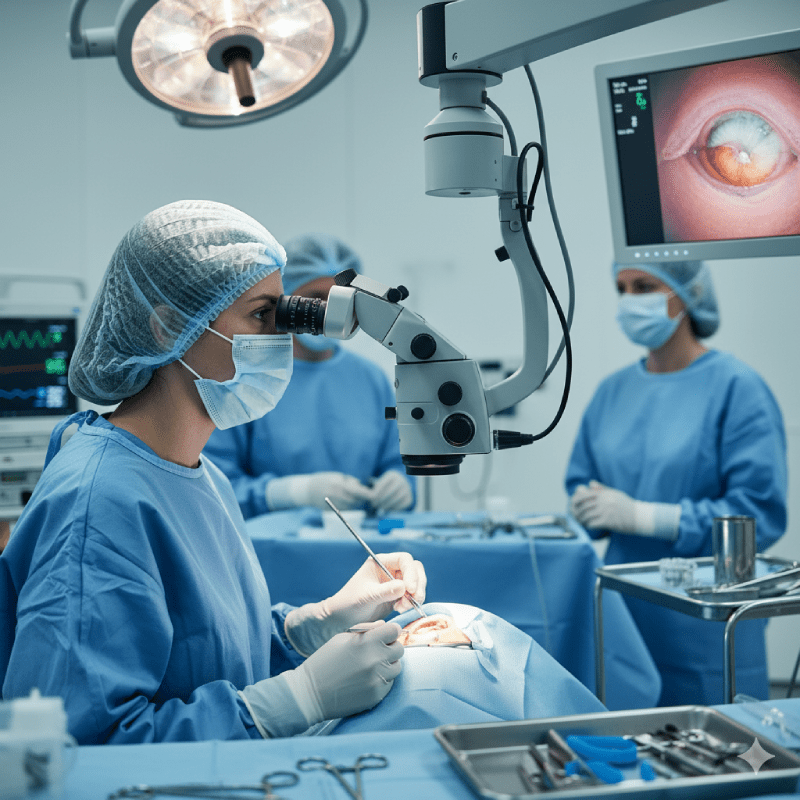
Can Laser Treatment Be Applied To Patients With Dry Eyes?
Laser treatment can be applied to patients with mild or moderate dry eyes with intensive moisturizing drops used before and after the treatment. However, it may be risky for patients with severe dry eyes. In such cases, the doctor recommends alternatives like PRK or ICL lens that do not increase the risk of dryness.
How Successful Is The Monovision Technique For Presbyopia?
The success of the Monovision LASIK technique depends on the patient’s brain adaptation ability. This technique allows approximately 80% of patients to achieve comfortable, glasses-free vision at distance and near. However, some patients may find it difficult to adapt to the difference between the two eyes. Testing Monovision with contact lenses before the surgery helps determine the patient’s suitability.
Are Post-Operative Check-Ups Charged?
Post-operative control appointments (usually the next day, 1 week, 1 month) are generally included in the package price and are free of charge. Long-term controls (6 months, 1 year) are also provided free of charge for a certain period. The patient is only obligated to cover the travel expenses (airfare) required for these controls. Regular follow-up guarantees the long-term success of the treatment.
How Does The Quality Of Laser Devices In Turkey Compare To International Standards?
Leading eye centers in Turkey use the latest generation laser devices (Femto-LASIK, Wavefront) from world-leading brands (ZEISS, Alcon). The quality and up-to-dateness of these devices are fully compliant with international standards. This technological assurance eliminates the risk of technical failure and increases the success rate, making receiving treatment in Turkey reliable.
Which Situations Should Lens Treatment Be Preferred Over Laser For Getting Rid Of Glasses?
Lens treatment (Trifocal/EDOF or ICL) should be preferred over laser in these situations: 1) The prescription is very high and the cornea is too thin for laser, 2) There is cataract in the eye, 3) The patient is over 40 and wants a permanent solution for both far and near vision (presbyopia). Lens treatments offer a more permanent and safer solution in these complex cases.
How Does Cure Holiday Provide Support In The Treatment Process?
Cure Holiday acts as a bridge of trust and organization for patients in hypermetropia treatment. It selects the best JCI-accredited eye centers and expert surgeons suitable for the patient’s needs and budget. It organizes all logistical processes (VIP transfer, luxury accommodation) and provides uninterrupted interpreter support, ensuring the patient focuses on treatment without stress and decides to receive treatment in Turkey with confidence.
